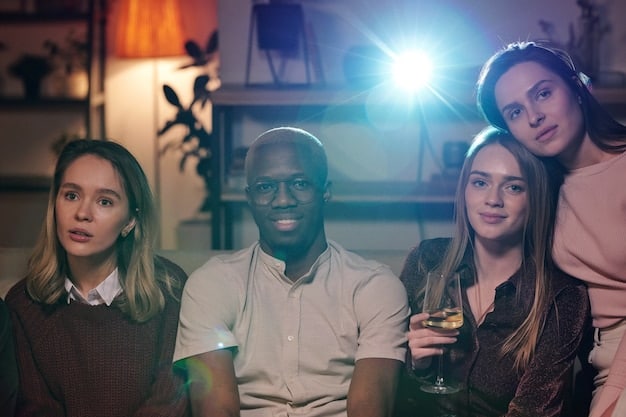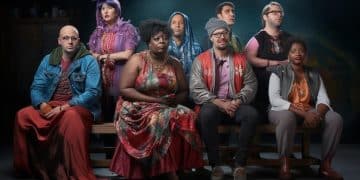The Art of the Ensemble Cast: TV Group Dynamics Explored

The art of the ensemble cast in television celebrates the intricate dynamics of group chemistry, proving that shared storytelling elevates narratives beyond individual performances, fundamentally enhancing a series’ impact and longevity.
The magic of television often lies not just in a compelling plot or a charismatic lead, but in the intricate dance of multiple characters harmonizing on screen. This is the essence of The Art of the Ensemble Cast: Celebrating the Best Group Dynamics in TV History.
The Alchemy of Collaborative Storytelling
Television’s most enduring series frequently owe their legacy to the intricate interplay of their ensemble casts. Unlike single-protagonist narratives, these shows thrive on the collective energy, diverse perspectives, and evolving relationships of a group of characters, each essential to the narrative fabric. This collaborative storytelling elevates the viewing experience, creating rich, multi-layered worlds that resonate deeply with audiences.
A truly great ensemble cast is more than just a collection of talented actors; it’s a living, breathing entity where chemistry sparks in every interaction. Consider the subtle glances, the shared inside jokes, or the palpable tension that can only emerge from relationships forged over dozens, or even hundreds, of episodes. This organic development of dynamics is what sets ensemble casts apart, allowing viewers to invest in multiple character arcs simultaneously. When characters grow together, face challenges side-on, and support each other through thick and thin, the emotional payoff for the audience is profoundly amplified. It’s a testament to the power of shared experience, both on and off-screen.
Defining Ensemble Excellence
What precisely constitutes an excellent ensemble cast? It’s a confluence of several crucial elements that contribute to a seamless and compelling on-screen dynamic.
- Balanced Character Development: Each character, regardless of screen time, feels fully realized and integral to the plot. No one is a mere accessory.
- Organic Chemistry: The interactions between characters feel natural and spontaneous, reflecting genuine relationships, whether they are familial, romantic, professional, or platonic.
- Shared Narrative Weight: The story doesn’t lean solely on one protagonist. Major plotlines and emotional beats are distributed among multiple characters, making each contribution vital.
- Adaptability and Evolution: The group dynamics can evolve authentically over seasons, reflecting changes in character relationships and external circumstances.
This balance ensures that no single character overpowers the narrative, allowing each actor the space to shine while contributing to a larger, cohesive whole. The collective performance becomes the star, rather than individual turns.
The careful casting process is often where the initial magic happens. Directors and casting agents seek not just individual talent, but actors who can genuinely connect and build believable rapport. Rehearsals, improvisation exercises, and off-screen bonding activities can further cultivate this chemistry, helping performers to inhabit their roles more fully and to react authentically to their scene partners. Ultimately, the success of an ensemble lies in its ability to create a world where every character feels indispensable and every interaction contributes to the overall narrative tapestry. This collaborative spirit makes an ensemble cast truly exceptional.
The Foundations of Strong Group Dynamics
The bedrock of any successful ensemble cast lies in the intricate foundations upon which their group dynamics are built. It’s a delicate balance of writing, direction, and performance that allows these fictional relationships to feel authentically real to the audience. When these elements align, the result is a narrative ecosystem where every character contributes, and every interaction carries weight. Understanding these foundational aspects helps us appreciate the complexity behind seemingly effortless on-screen chemistry.
The Role of Scriptwriting
A strong script is the blueprint for any compelling ensemble. Writers meticulously craft dialogue, subplots, and character arcs that allow each member of the cast to have their moment in the spotlight, while simultaneously weaving their individual stories into the broader narrative.
- Distinct Voices: Each character must speak and act in a way that is unique and recognizable, reflecting their personality, background, and motivations.
- Interconnected Storylines: Individual character arcs should influence and be influenced by the arcs of others within the ensemble, creating a sense of shared destiny.
- Conflict and Resolution: Healthy ensemble dynamics often feature internal conflicts that test relationships, leading to resolutions that deepen bonds or reveal new facets of characters.
Without a robust script that understands and prioritizes these multi-character interactions, even the most talented actors would struggle to create believable group dynamics. The writing provides the scaffolding upon which these relationships can grow and flourish, ensuring that every plot point serves to advance not just a single character, but the entire group.
Beyond direct dialogue, scriptwriting also shapes the non-verbal interactions that are so crucial to ensemble chemistry. It dictates who shares a scene, who eavesdrops, who offers subtle support, or who creates tension through their mere presence. These seemingly small details, all meticulously planned in the script, contribute immeasurably to the organic feel of a thriving ensemble. Moreover, a good script allows for moments of levity and vulnerability, preventing the characters from becoming one-dimensional. This layering of emotion and circumstance helps to forge a group that feels genuinely lived-in and relatable, drawing the audience deeper into their shared world.
Iconic Ensembles: Case Studies in TV Excellence
Examining specific examples provides invaluable insight into what makes an ensemble truly iconic. These series stand out not just for their individual brilliance, but for the indelible mark left by their collective cast performances and the enduring dynamics they created. Each show offers a unique masterclass in group interaction, showcasing diverse approaches to building and maintaining a compelling ensemble.
“Friends”: The Quintessential Sitcom Ensemble
“Friends” is arguably the gold standard for sitcom ensembles. Its enduring appeal lies in the effortless, almost familial chemistry shared by its six core characters. The show’s premise – six young adults navigating life and love in New York City – relies entirely on their interconnected lives and the support they provide one another.
What made “Friends” revolutionary was its commitment to showcasing the daily, mundane, yet profoundly meaningful interactions that define real friendships. From Central Perk coffee shop gatherings to shared apartments, every scene reinforced their unbreakable bond. The dynamic was never about a single protagonist, but about how each character’s quirky personality complemented and challenged the others, leading to both comedic genius and heartfelt moments. Their evolution over a decade felt earned because it was always a collective journey, reflecting the true nature of long-term relationships where individual growth is often a result of shared experiences.
“The Wire”: A City as the Ensemble
In stark contrast to the intimate, personal dynamics of “Friends,” “The Wire” presented an ensemble on an epic scale. Here, the “group” wasn’t just a set of characters, but an entire city – Baltimore itself, with its interwoven institutions of law enforcement, drug trade, politics, education, and journalism.
- Systemic Ensemble: Characters represented different facets of a complex urban ecosystem, their interactions illustrating systemic failures and human resilience.
- Authenticity: The cast, often featuring local actors and method approaches, brought a gritty realism that mirrored the show’s uncompromising vision.
- Intersectional Narratives: Storylines constantly overlapped and impacted one another, showcasing how individual actions ripple through an entire community.
“The Wire” proved that an ensemble can extend beyond a confined group, using multiple perspectives to paint a comprehensive, unvarnished portrait of societal structures. The ensemble here was less about comedic timing and more about dramatic heft, with each character serving as a crucial cog in a larger, sprawling narrative machine.

“Succession”: The Dysfunctional Family Unit
Shifting gears to contemporary drama, “Succession” offers a masterclass in dysfunctional ensemble dynamics. The Roy family, a media mogul dynasty, is bound by blood and power, yet constantly at war with itself. The brilliance of this ensemble lies in its ability to highlight the corrosive effects of privilege and ambition within a family unit.
Each Roy sibling, and indeed wider family members and associates, vies for dominance and Logan Roy’s approval, creating a perpetual state of tension and shifting allegiances. The actors perfectly convey the blend of genuine affection, deep-seated resentment, and strategic manipulation that defines their relationships. The group dynamics are less about unity and more about the compelling, cringe-worthy spectacle of a family tearing itself apart, yet paradoxically unable to fully disconnect. “Succession” demonstrates that an ensemble can be riveting even when characterized by conflict rather than cohesion.
Beyond the Screen: The Production of Chemistry
The captivating dynamics we see on screen are rarely accidental; they are meticulously cultivated through a combination of thoughtful production choices, strategic direction, and dedicated actor collaboration. The “art” of the ensemble cast extends deeply into the behind-the-scenes processes, where the foundation for on-screen chemistry is laid. It’s a testament to the belief that strong relationships off-screen can significantly enhance performances.
Casting & Rehearsal Strategies
The initial casting process is perhaps the most critical step. Directors and casting teams often go beyond individual auditions, bringing together potential cast members in various combinations to gauge their natural rapport. This “chemistry read” is vital for identifying who truly clicks with whom, ensuring that the foundational elements for believable relationships are present from the start.
- Chemistry Reads: Actors are paired or grouped to perform scenes, allowing producers to observe their natural interaction and energy.
- Ensemble Workshops: Before filming, casts might participate in workshops or team-building exercises, creating a shared history and rapport.
- Improvisation Sessions: Encouraging improv can help actors to develop their characters’ voices and reactions organically within the group dynamic.
These strategies move beyond mere talent acquisition to focus on relational potential, recognizing that the sum is greater than its individual parts in an ensemble. The goal is to foster an environment where actors feel safe to experiment, take risks, and truly listen and respond to one another.
Once cast, rehearsals are not just about memorizing lines, but about exploring the subtext of relationships. Directors often encourage actors to discuss their characters’ backstories, their feelings toward others in the group, and to find the nuances in their interactions. This deep dive into character psychology within the group context helps to build a shared understanding and creates a more authentic portrayal of the ensemble’s dynamics. The more connected the actors feel off-screen, the more believable their on-screen relationships become. This commitment to fostering genuine bonds is a hallmark of productions aiming for ensemble excellence.
The Audience Connection: Why Ensembles Resonate
The enduring appeal of ensemble casts lies in their profound ability to forge a deep, personal connection with the audience. Unlike narratives centered on a single hero, ensembles offer a broader spectrum of characters and experiences, increasing the likelihood that viewers find someone, or something, to personally relate to. This multi-faceted engagement fosters a sense of community, both within the show’s fictional world and among its real-world viewership.
Relatability and Diverse Perspectives
Ensemble casts often mirror the complexities of real-life social groups, whether they are families, workplaces, or circles of friends. This inherent relatability is a major draw.
- Mirroring Life: Audiences see reflections of their own relationships, conflicts, and joys in the on-screen dynamics.
- Multiple Entry Points: With several distinct personalities, viewers are more likely to find a character whose struggles, triumphs, or perspectives resonate with their own experiences.
- Exploration of Interpersonal Dynamics: Ensembles allow for a rich exploration of how different personalities interact, solve problems, and support each other, offering insights into human behavior.
This diversity of perspectives provides a richer, more nuanced understanding of the narrative’s themes, making the story more accessible and impactful to a wider audience. When audiences see themselves reflected in a variety of characters, the emotional investment deepen considerably.
The evolving nature of ensemble dynamics also plays a crucial role in maintaining audience interest over long runs. Just as real relationships develop and change, so too do the bonds within an effective ensemble. Viewers become invested in seeing how characters grow together, overcome obstacles, and adapt to changing circumstances. This longitudinal investment creates a powerful sense of shared journey. The communal aspect of watching also connects viewers to each other. Discussing beloved ensemble casts, debating character pairings, and sharing favorite moments becomes a collective experience that extends the show’s impact beyond its airtime, building a loyal fan base that celebrates the “family” on screen.

Challenges and Pitfalls in Ensemble Storytelling
While the benefits of an ensemble cast are immense, the execution is far from simple. Crafting a successful ensemble narrative comes with its own unique set of challenges that, if not carefully managed, can derail even the most promising series. Navigating these pitfalls requires exceptional writing, sensitive direction, and an understanding of the delicate balance required to keep multiple storylines compelling and cohesive.
Maintaining Balance and Avoiding Character Bloat
One of the primary difficulties in ensemble storytelling is ensuring that every character receives adequate attention without overwhelming the narrative.
- Uneven Development: Some characters might inadvertently capture more focus, leaving others underdeveloped or sidelined.
- Too Many Cooks: Introducing too many characters or storylines can dilute the impact of each, leading to a cluttered and confusing narrative.
- Loss of Purpose: Characters can lose their narrative relevance if not continuously integrated into significant plotlines.
The art lies in knowing when to give a character a spotlight episode and when to allow them to serve a supporting role, always ensuring their presence feels justified and meaningful within the larger group dynamic. This requires constant vigilance from the writing team to prevent any single character from overshadowing the others entirely.
Another common pitfall is the degradation of chemistry over time. As shows run for many seasons, actors’ personal lives or creative desires might shift, potentially impacting the on-screen rapport. Writers may also struggle to find fresh conflicts and resolutions for characters who have been together for years, leading to repetitive dynamics or forced drama. The challenge then becomes how to organically evolve relationships and introduce new elements without betraying the established bonds that made the ensemble beloved in the first place. This delicate tightrope walk between evolution and consistency is crucial for the longevity of any ensemble cast, especially those that aim to retain their core appeal while exploring new narrative avenues.
The Enduring Legacy of the Ensemble Cast
The impact of a well-crafted ensemble cast extends far beyond the final credits of a series. These groups of characters, through their intricate dynamics and shared journeys, leave an indelible mark on television history and in the hearts of viewers. Their legacy is built on the foundation of authenticity, relatability, and the powerful notion that collective strength often surpasses individual prowess.
Shaping Television Narratives
Ensemble casts have fundamentally reshaped how television narratives are structured and consumed. They challenged the traditional single-protagonist model, demonstrating that audiences could effortlessly invest in multiple character arcs simultaneously. This shift opened doors for more complex, multi-layered storytelling that better reflects the intricate web of relationships in real life.
- Character-Driven Plots: Ensembles foster narratives driven by the relationships and interactions between characters, rather than solely by external events.
- Longevity and Re-watchability: The rich tapestry of interconnected lives often leads to shows with long runs and high re-watch value, as viewers continually discover new nuances in the dynamics.
- Influence on Future Series: The success of iconic ensembles inspires new generations of creators to prioritize group dynamics and shared storytelling.
This enduring influence ensures that the “ensemble” approach remains a vital and celebrated cornerstone of television production, continually evolving to meet new creative challenges and audience expectations.
The emotional resonance of ensemble casts is perhaps their greatest legacy. For many viewers, these fictional groups become surrogate families, friends, or colleagues, offering comfort, laughter, and catharsis. The shared experience of witnessing their triumphs and failures creates a powerful bond that transcends the screen. When a beloved ensemble series concludes, it often feels like saying goodbye to cherished companions, a testament to the profound connection forged over years of shared viewing. This deep emotional investment is the ultimate validation of the art of the ensemble cast – a phenomenon that continues to enrich the landscape of television and remind us of the power of collective storytelling.
| Key Aspect | Brief Description |
|---|---|
| ✨ Ensemble Definition | Multiple characters with balanced importance, intertwining storylines, and shared narrative weight. |
| 🎭 Chemistry Production | Achieved through careful casting, chemistry reads, and strong scriptwriting for realistic interactions. |
| 🤝 Audience Connection | Viewers relate to diverse perspectives, fostering deep emotional investment and a sense of community. |
| ⚠️ Challenges | Avoiding character bloat, maintaining balance, and keeping chemistry fresh over long series runs. |
Frequently Asked Questions About Ensemble Casts
▼
An ensemble cast is characterized by having multiple lead characters, each with significant screen time and interwoven storylines, where no single character dominates the narrative. Their collective dynamic and individual contributions are equally vital to the show’s progression.
▼
Ensemble casts resonate because they offer diverse perspectives and more points of relatability, mimicking real-life groups. This allows viewers to connect with various characters and their dynamics, fostering a deeper sense of investment and prolonging enjoyment over many seasons.
▼
Chemistry is paramount. It ensures interactions feel natural and authentic, elevating performances beyond individual talent. Producers often conduct “chemistry reads” during casting to ensure actors can build believable rapport, which translates directly to more compelling on-screen group dynamics.
▼
Writers must balance individual character development with the overall group narrative, avoid character bloat, and ensure every character remains relevant. Maintaining fresh and evolving dynamics over a show’s run without resorting to repetitive or forced conflicts is also a significant challenge.
▼
A strong ensemble cast can certainly elevate a show, and exceptional chemistry can mask some plot deficiencies. However, while compelling characters can sustain interest for a time, a fundamentally weak or inconsistent plot will eventually undermine even the best ensemble, as audiences crave coherent storytelling.
Conclusion
The art of the ensemble cast is a cornerstone of compelling television, demonstrating time and again that the collective power of intertwined characters can create narratives of profound depth and lasting resonance. From the witty banter of “Friends” to the systemic complexities of “The Wire” and the fraught family drama of “Succession,” these shows underline the enduring appeal of watching a group of individuals navigate life’s challenges together. The meticulous craft of writing, directing, and casting, coupled with the authentic chemistry between actors, transforms a collection of performances into a living, breathing social unit that captivates and connects with audiences globally. The legacy of these exceptional group dynamics continues to inspire future generations of storytellers, firmly cementing the ensemble cast as a truly vital and celebrated element in the ever-evolving landscape of television.





